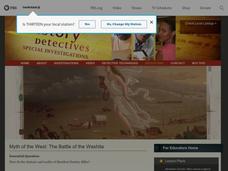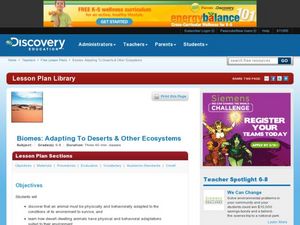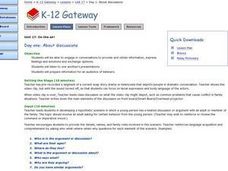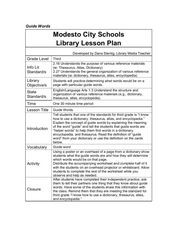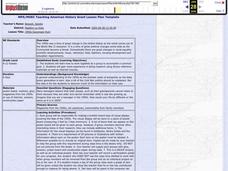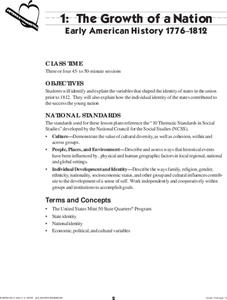College Board
2009 AP® Calculus BC Free-Response Questions Form B
Let them eat cake. The free-response questions from an AP® Calculus BC exam cover several topics that include finding the area under a curve within the context of creating a birthday cake. Calculus concepts include finding rates of...
Council for the Curriculum, Examinations and Assessment
Health and the Whole Person
To begin the second year of a health and wellness course, class members review the aspects of social, physical, emotional, cognitive, and spiritual health investigated the previous year. After completing the...
Center for Learning in Action
Density
Explore the concept of density within states of matter—gases, liquids, and solids—through a group experiment in which young scientists test objects' texture, color, weight, size, and ability to sink or float.
Teach Engineering
Understanding the Air through Data Analysis
Is there a correlation or causation relationship between air pollutants? Groups develop a hypothesis about the daily variation of air pollutants, specifically ozone and CO2. Using Excel to analyze the data, the groups evaluate their...
PBS
Myth of the West: The Battle of the Washita
Go West, young man! Scholars use PBS video clips, slide shows, and interactive materials to create a picture of Manifest Destiny in the American West. Using a variety of primary and secondary sources, young historians learn about the...
Missouri Department of Elementary
Conflict Mediation – Part 2: Practice
A lesson challenges scholars to prove their understanding of conflict mediation. Small groups role-play scenarios using two mediators and two disputants. Peers observe then discuss their findings. A worksheet outlines groups'...
Missouri Department of Elementary
Opportunity Knocks, But It Costs, Too!
Sixth graders practice six steps to effective problem solving. Working with the school counselor, class members are presented with a scenario that requires them to make a decision. Individuals then write a reflection in which they...
Curated OER
Materials, Let's Do the Life Cycle
Students examine environmental and social impacts of products that consumers buy. In this environmental stewardship lesson, students play a game that requires them to consider real costs of products. Students consider the environmental...
Curated OER
Biomes: Adapting To Deserts & Other Ecosystems
Young scholars examine how animals must be adapted to the conditions of its environment to survive. In this biomes lesson students research desert adaptations then discuss how these animals have survived.
Curated OER
About Discussions
Students exchange opinions, express feelings, and listen to presentations of others about an argument. In this discussion lesson plan, students learn how to listen and respond for an argument they intend to have.
Facing History and Ourselves
A Scene from a Middle School Classroom
Citizens in the modern world can't imagine making the same social choices made by many Germans in the 1920s and 1930s, but they don't realize that they actually do it every day by ostracizing others. A case study of middle schoolers...
US Department of Education
Early Childhood: Five Themes of Geography
Any preschool teacher would be thrilled to have a resource like this one. It includes activity ideas, discussion leads, book suggestions, and a glossary for learners ages 2 - 5. The entire booklet focuses on ways to teach young children...
Curated OER
Guide Words
Third graders investigate guide words. In this library lesson, 3rd graders investigate guide words in reference materials and complete an alphabetizing worksheet.
Curated OER
Dinosaurs---Read All About Them!
Students read all about dinosaurs. In this biology lesson plan, students examine how to use library research as integral part of scientific research.
Curated OER
1950's Scavenger Hunt
Students encounter how to work together as a group to accomplish a common goal. They gain more experience in doing research using library reference materials as well as internet sources. Each group is responsible for making a bulletin...
Curated OER
At the Edge of the Continent
Students study how to interpret a bathymetric map. They study the main features of the continental margin. They plot and graph bathymetric data. They think about and discuss the bathymetry of the edge of the cont
PBS
Primary Sources
Students see how to use primary and secondary sources to investigate history. Whether it is a photograph, book, map, letter, postcard, newspaper, or official document, students can use sources to reconstruct and relive history.
Curated OER
Skinny and Fat Questions
Students practice the techniques and strategies of how to ask questions. They assess how to generate a question that corresponds to the reading that they have done recently. A PowerPoint is shown to the students to instruct them on the...
Curated OER
So You Think You're Tough
Fourth graders learn how to classify animals. In this invertebrates lesson, 4th graders discuss how we classify thinks into groups and move into a discussion about classifying animals. Students learn about the differences between...
US Mint
The Growth of a Nation
Young historians explore the identity of the early United States in this four-part instructional activity series. Working in groups of three, students research the political, economic, and cultural atmosphere of each...
Curated OER
Stirring up Fractions
Second graders practice unit fractions to identify parts of the whole and parts of a set. They utilize a variety of manipulative's including recipe boxes to get them started stirring up fractions. A multitude of books on fractions are...
Curated OER
Creating a Watermark
Students discover how to insert a watermark into a Word document. In this word processing instructional activity, students follow step-by-step instructions to add either a picture watermark or a text watermark to the background of...
Curated OER
Earthquakes: Getting Ready For The Big One
Students devise a plan to prepare a city for an earthquake. For this lesson on earthquakes, students differentiate between the different types of earthquakes, examine the impact they can have on a city, and write a proposal on how to...
Curated OER
How Do The Colors of Light Mix?
Students investigate the mixing of light. They form a hypotheses to reason why color changes occur and they write conclusions and ask new questions arising from the investigation. Students identify the primary and complementary colors of...




